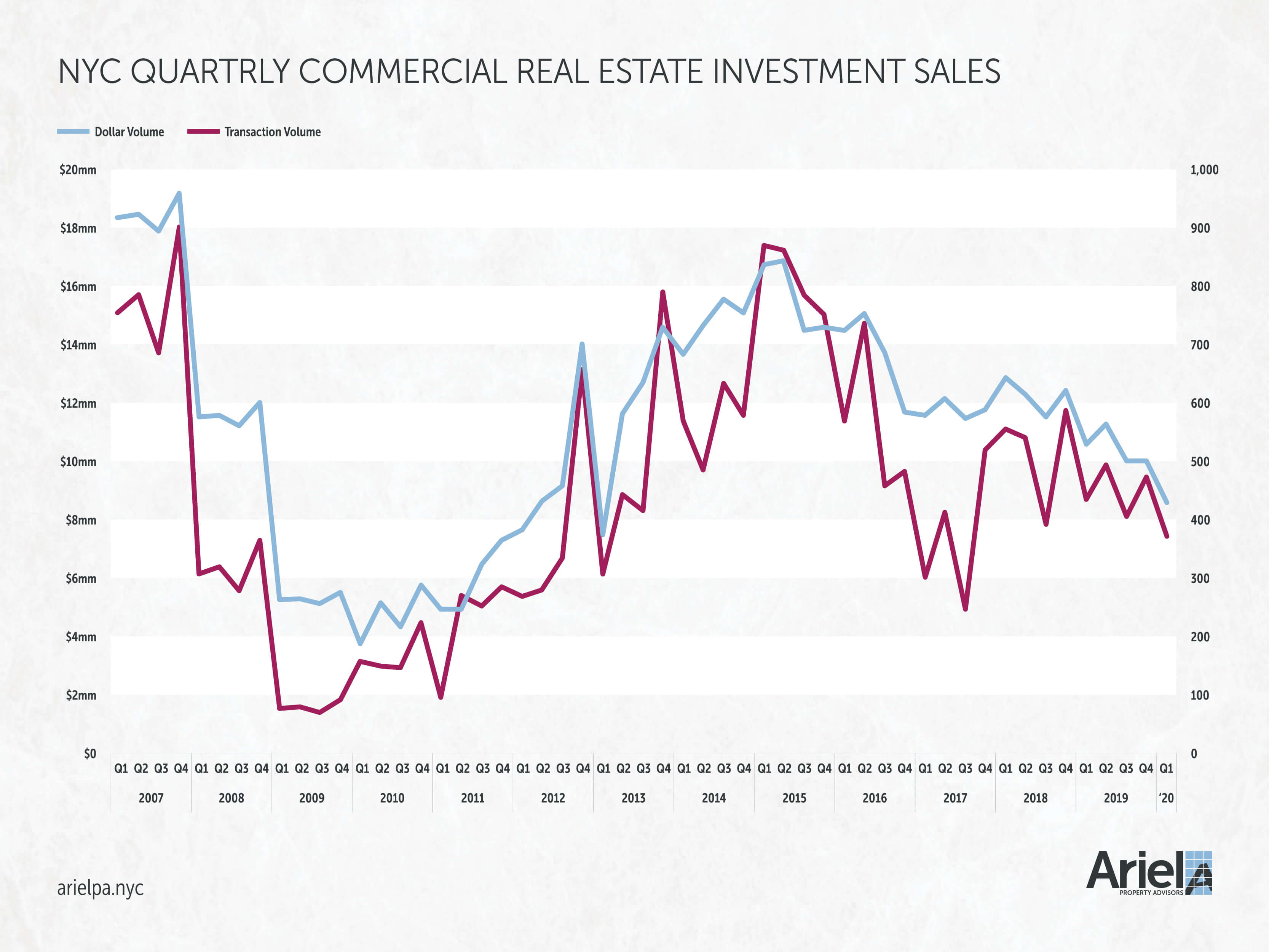Originally Published in

May 7, 2020
By Shimon Shkury, Ariel Property Advisors
Read The Article on Forbes
If you’re like many real estate investors or brokers right now, morning meetings have evolved into updates on lender forbearance, the tenuous state of rent and predictions that can shift with the next headline. Normally, you can expect capital and investor diversity, especially in New York City, one of the most liquid real estate markets in the world. Now we’re seemingly at a standstill—with some exceptions, like opportunistic investment, buyers transferring tax-deferred status to new acquisitions (i.e. 1031 tax deferment) and some less traditional lending avenues.

Shimon Shkury,
President and Founder,
Ariel Property Advisors
Covid-19 presented New York City landlords with serious rent collection issues. According to an April 2020 survey of owners conducted by my company, Ariel Property Advisors, collections fell to an unprecedented one month slide: retail is at 30% or less, office is about 50% and residential is between 50 and 85%, depending on location and unit status (i.e. market-rate, rent-stabilized or affordable). Rent is expected to decrease further in the near term, and this means short-term instability, and some difficult conversations with tenants and lenders.

However, there are reasons to be optimistic. You need to be smarter about your investment decisions, certainly, as well as how you deal with your tenants and lenders, but there are opportunities to come out of this ahead. Remember that the current slowdown is mainly due to extrinsic market factors rather than fundamental issues with the real estate economy.
Here’s what you need to consider while making your decisions.
Tenant-Landlord Relationships
This is an opportunity for landlords to build good will with tenants by negotiating. First, it’s the right thing to do. Second, New York City landlords have weak leverage under Governor Andrew Cuomo’s 90-day non-eviction order. Landlord concessions range from outright short-term rent forgiveness to partial monthly rent deferrals. Another creative solution on the commercial side is lease extensions with favorable terms in return for some certainty of payment from tenants to the landlord, resulting in a win-win in an unpredictable market. For owners, this keeps your building occupancy up and thus the sale value of your property.
Landlord-Lender Relationships
Most owners won’t approach lenders about forbearance unless absolutely necessary. Lenders will generally ask for collections and proof of material change if presented with this, and commercial landlords want to ensure their lender relationship stays solid for future financing needs. That said, Freddie Mac has already announced a forbearance program for its borrowers, and many community lenders have followed suit.
This has allowed landlords to ease up rent collections over this 90-day period, contributing to the standstill. While this is hurting the market in the short term, this helps to keep the market alive in the long term. Recent history shows that mass foreclosures will hurt property values, so it’s in everyone’s interests to build good will and work together.
The Short-Term Outlook
Second quarter transaction volume is extremely important to watch. There is a high likelihood that it could be the lowest volume quarter in more than a decade in New York City for all product types. For comparison, in 2009, during the Great Recession, there were approximately $6.27 billion in sales, 10% of 2007’s $62.46 billion in sales.
First quarter 2020 transactions were already low before Covid-19 hit the U.S., and the second half of March has been dismal for trade volume. The first quarter of 2020 was 15% lower than first quarter 2019 and 33% lower than in first quarter 2018. However, first quarter 2020 numbers are lagging indicators of transactions that were in contract pre-pandemic, primarily from January and February. The first half of March closed in keeping with January and February. The majority of closings that were scheduled for the second half of March was either deferred or fell out of contract.
Second quarter 2020 is expected to consist almost solely of closings in contract prior to the lockdown and at least half of these are likely to be delayed. Buyers are reassessing pricing and many banks are holding back on lending.
Six Months From Now
Pricing in six months will depend on the speed of the recovery and the product type. You’ll need to assess your opportunities on a case-by-case basis. One possible scenario is that New York City recovers to 50% activity by mid-July.
While retail prices are expected to decline in value over the next 18 months, this asset class was already struggling before the pandemic. Because of the lockdown, some retail tenant types, particularly restaurants, are likely to experience a large amount of closures, and the increase in already-high vacancy rates would continue to drive down property values.
Market-rate multifamily assets, on the other hand, present an opportunity for relative stability, as transaction volume for this asset class is likely to decrease in anticipation of more regular rent collections. There is also expected to be more aggressive capital demand in the coming months. This, combined with fewer investment sales transactions, may lead to higher asset values and more consistent pricing.
Meanwhile, majority rent-stabilized multifamily buildings will have downward pricing pressure as anticipated rent collections will likely stay lower than usual for six to 12 months after the crisis. Landlords of rent-stabilized units, mostly throughout the Outer Boroughs, will have limited recourse for collecting rent, due to city and state regulations. This, coupled with The Housing Stability and Tenant Protection Act of 2019, put rent-stabilized multifamily assets in a vulnerable position.
The office market is less clear. On one hand, it’s anticipated that vacancies will rise for office buildings and many companies will reduce their space needs because of lower headcounts and the adoption of remote working strategies that are currently being stress-tested for effectiveness. On the other hand, health regulations and employee anxiety about shared spaces may result in at least short-term social distancing, which would require low-density space needs and thus more square-footage.
Watch the Market
The important thing is to watch the market. There aren’t enough transactions to provide meaningful pricing guidance at the moment, and that may not change for at least 90 days. For now, try to identify the market’s pain points and let that guide your decisions. Look to the lenders, who may lower prices on debt over the coming months, and find the asset markets where more capital is available.
Overall, there is more specific and more limited capital and investment available to transact today, but while the near future seems gloomy, the market will stabilize, so take the long view. While some capital providers will see the market landscape and exit New York City, this will actually open up opportunities for longer-term capital to be placed, especially if landlords, tenant and lenders work with each other to weather this storm, and indications show they are doing just that.
It’s also important to remember that New York City is still the dominant economic market in the U.S. and this is not going to change because of Covid-19. There is a reason why the city has such a long history of relative stability in the real estate sector: even during a crisis like the one we’re experiencing, the market can withstand it.
More information is available from Shimon Shkury at 212.544.9500 ext.11 or e-mail sshkury@arielpa.com.